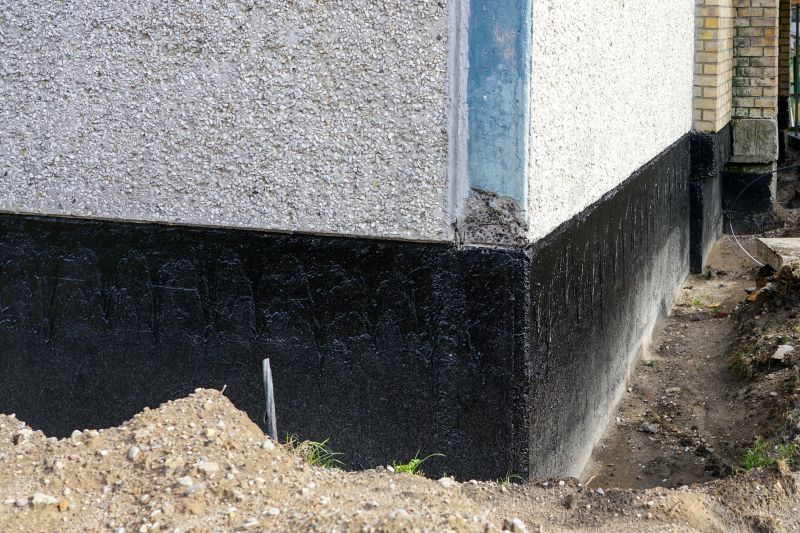Expert Picks For Foundation Leak Repair Supplies You Can Rely On
Find high-quality repair products recommended by professionals to ensure effective sealing and leak prevention.
 Foundation leak repairs are essential for maintaining the structural integrity and safety of a building. When leaks occur, they can lead to water intrusion, which may cause interior damage, mold growth, and deterioration of the foundation material over time. Addressing these issues promptly with the right products can help prevent further damage and extend the lifespan of the foundation. There are various solutions available, ranging from sealants and waterproofing membranes to specialized patching compounds and drainage systems. Selecting the appropriate products depends on the severity of the leak, the type of foundation, and the environmental conditions surrounding the property.
Foundation leak repairs are essential for maintaining the structural integrity and safety of a building. When leaks occur, they can lead to water intrusion, which may cause interior damage, mold growth, and deterioration of the foundation material over time. Addressing these issues promptly with the right products can help prevent further damage and extend the lifespan of the foundation. There are various solutions available, ranging from sealants and waterproofing membranes to specialized patching compounds and drainage systems. Selecting the appropriate products depends on the severity of the leak, the type of foundation, and the environmental conditions surrounding the property.
Top Overall Option
High-Performance Foundation Sealant
A versatile and durable sealant designed for sealing cracks and joints in concrete and masonry foundations. It offers excellent adhesion, flexibility, and resistance to water and temperature fluctuations, making it suitable for both interior and exterior applications. Proper surface preparation and application are essential to maximize its effectiveness and ensure long-lasting results.
Types of Products For Foundation Leak Repairs
Hydraulic Cement
A quick-setting material ideal for sealing active leaks and cracks in concrete and masonry foundations.
Liquid Waterproofing Membranes
Flexible coatings applied to exterior surfaces to create a waterproof barrier against moisture intrusion.
Polyurethane Sealants
High-adhesion sealants that expand and contract with foundation movements, suitable for sealing cracks and joints.
Bituminous Coatings
Heavy-duty waterproof coatings that provide a protective layer on foundation surfaces exposed to water.
Drainage Systems
Sub-surface or surface drainage solutions that divert water away from the foundation to prevent leaks.
Epoxy Injection Kits
Used to fill and seal cracks from the inside, restoring structural integrity and preventing water penetration.
Waterproofing Paints
Coatings designed to be painted onto foundation walls to provide an additional moisture barrier.
Rubberized Sealants
Flexible sealants suitable for sealing joints and cracks that experience movement.
Polyurethane Foam
Expanding foam used for sealing larger cracks and gaps in foundation walls.
Foundation Patches
Pre-mixed patching compounds for filling small holes and surface imperfections.
Waterproofing Sheets
Rigid or flexible sheets installed on foundation surfaces to block water ingress.
Crack Repair Tubes
Pre-packaged tubes for precise application of sealant into cracks.
Popular Choices
Widely used for sealing small to medium cracks in foundation walls to prevent water intrusion.
Commonly applied to interior and exterior surfaces to add a moisture-resistant layer.
Popular for quick repairs of active leaks and cracks in concrete foundations.
Effective for sealing larger gaps and cracks due to their expanding properties.
Used to improve water flow away from foundation surfaces and reduce leak risks.
Commonly selected for exterior waterproofing applications on foundation walls.
Favored for internal crack repairs that require structural reinforcement.
Popular for sealing joints and cracks that experience movement or expansion.
Often used in combination with other products for comprehensive waterproofing solutions.
Widely used for surface repairs and filling small holes in foundation surfaces.
Effective foundation leak repair often begins with identifying the source of the leak accurately. Once diagnosed, the repair process may involve sealing cracks with high-quality sealants, installing waterproof membranes to create a moisture barrier, or applying hydraulic cement for quick patching of active leaks. For ongoing issues, waterproof coatings and drainage improvements can provide long-term solutions. It is crucial to choose products that are compatible with the foundation material and capable of withstanding the environmental stresses they will face.
Proper application of repair products is vital for achieving optimal results. This may require surface preparation such as cleaning and drying, followed by precise application according to manufacturer instructions. In some cases, multiple products may be used in combination to address different aspects of the leak. Regular inspection and maintenance are also recommended to ensure that the repairs remain effective over time. When considering foundation leak repair products, it’s important to prioritize quality and suitability for your specific needs to ensure a durable and reliable fix.
Key Buying Considerations
- Identify whether the leak is active or dormant to select the appropriate repair method.
- Assess the extent and size of the cracks or leaks to determine the right product type and quantity.
- Consider the foundation material (concrete, masonry, brick) to choose compatible repair products.
- Evaluate environmental conditions such as exposure to water, temperature fluctuations, and soil movement.
- Choose products with suitable application methods, whether for interior, exterior, or sub-surface use.
- Look for products with good adhesion and flexibility to accommodate foundation movements.
- Ensure the product provides a durable and long-lasting seal to minimize future repairs.
- Check for ease of application, especially if DIY repair is intended.
- Review manufacturer instructions and safety precautions for proper use and handling.
- Consider whether the product is suitable for both patching and waterproofing for comprehensive repair.
- Evaluate the drying or curing time to fit your repair schedule.
- Determine if additional surface preparation, like cleaning or priming, is necessary before application.
- Select products that are compatible with existing foundation coatings or sealants if applicable.
- Review customer feedback and ratings for insights into product performance and reliability.
This page contains affiliate links. We may earn a commission if you purchase through these links, at no additional cost to you.
